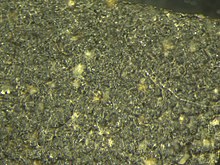| Lasiodiplodia theobromae | |
|---|---|

| |
| Lasiodiplodia theobromae sporulating in lesion on papaya | |
| Scientific classification | |
| Domain: | Eukaryota |
| Kingdom: | Fungi |
| Division: | Ascomycota |
| Class: | Dothideomycetes |
| Order: | Botryosphaeriales |
| Family: | Botryosphaeriaceae |
| Genus: | Lasiodiplodia |
| Species: | L. theobromae
|
| Binomial name | |
| Lasiodiplodia theobromae (Pat.) Griffon & Maubl.
| |
| Synonyms | |
|
Botryodiplodia ananassae | |
Lasiodiplodia theobromae is a plant pathogen with a very wide host range. It causes rotting and dieback in most species it infects. It is a common post harvest fungus disease of citrus known as stem-end rot. It is a cause of bot canker of grapevine.[2] It also infects Biancaea sappan, a species of flowering tree also known as Sappanwood.
On rare occasions it has been found to cause fungal keratitis,[3] lesions on nail and subcutaneous tissue.[4][5]
It has been implicated in the widespread mortality of baobab (Adansonia digitata) trees in Southern Africa. A preliminary study found the deaths to have a complex set of causes requiring detailed research.[6]
- ^ a b "Lasiodiplodia theobromae". NCBI taxonomy. Bethesda, MD: National Center for Biotechnology Information. Retrieved 1 December 2017.
Lineage( full ) cellular organisms; Eukaryota; Opisthokonta; Fungi; Dikarya; Ascomycota; saccharomyceta; Pezizomycotina; leotiomyceta; dothideomyceta; Dothideomycetes; Dothideomycetes incertae sedis; Botryosphaeriales; Botryosphaeriaceae; Lasiodiplodia
- ^ Identification and Pathogenicity of Lasiodiplodia theobromae and Diplodia seriata, the Causal Agents of Bot Canker Disease of Grapevines in Mexico. J. R. Úrbez-Torres, G. M. Leavitt, J. C. Guerrero, J. Guevara and W. D. Gubler, Plant Disease, April 2008, Volume 92, Number 4, pages 519-529, doi:10.1094/PDIS-92-4-0519
- ^ "Mycology Online - Lasiodiplodia theobromae". adelaide.edu.au. Archived from the original on 2008-10-07.
- ^ "Mycology Online -- Lasiodiplodia". Archived from the original on 2008-07-21. Retrieved 2012-10-05.
- ^ Summerbell, RC; Krajden, S; Levine, R; Fuksa, M (2004). "Subcutaneous phaeohyphomycosis caused by Lasiodiplodia theobromae and successfully treated surgically". Med Mycol. 42 (6): 543–7. doi:10.1080/13693780400005916. PMID 15682643.
- ^ "Archived copy" (PDF). Archived from the original (PDF) on 2012-06-19. Retrieved 2014-09-27.
{{cite web}}: CS1 maint: archived copy as title (link)